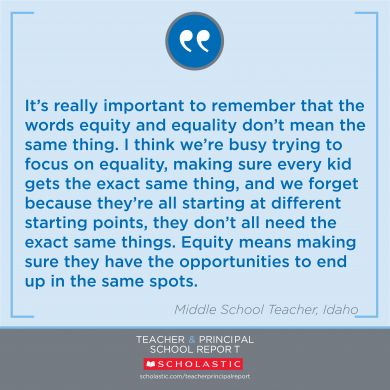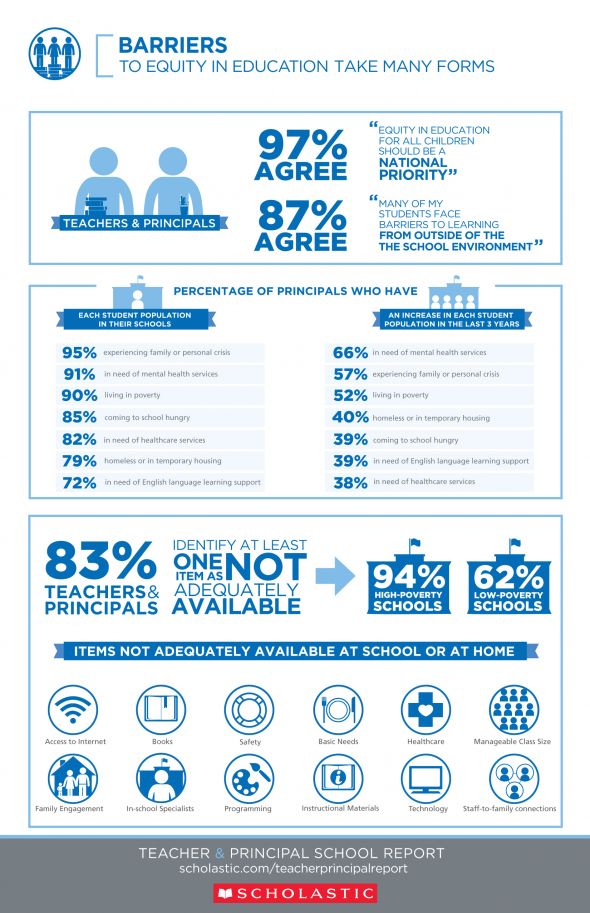 “Equity in education for all children should be a national priority.” That’s what the majority of teachers and principals told us as part of the new Teacher & Principal School Report: Equity in Education, out today.
“Equity in education for all children should be a national priority.” That’s what the majority of teachers and principals told us as part of the new Teacher & Principal School Report: Equity in Education, out today.
The report features the voices of more than 4,700 public school Pre-K–12 teachers and principals from all 50 states and the District of Columbia, sharing their views and experiences regarding the barriers to equity, educators’ funding priorities and personal spending for students and classrooms, the role of families and communities, and professional development needs.
To learn more, download the full report: www.scholastic.com/teacherprincipalreport
“Teachers and principals are on the front lines every day working hard to meet the needs of each individual student. In the Teacher & Principal School Report, educators in schools across poverty levels tell us that children are arriving at school in need of mental health services, living in poverty, or experiencing personal crisis—all conditions that create barriers to learning,” said Michael Haggen, Chief Academic Officer of Scholastic Education. “The report also shows us educators’ belief that given the right resources, including high-quality instructional materials, community and family partners, and professional development, they can provide a quality education for every young person who walks through their doors.”
Join the conversation on social media using #TeacherPrincipalReport and read key findings from the report, below:
Barriers to Equity in Education
- Teachers and principals across school poverty levels agree (87%) that many of their students face barriers to learning that come from outside the school environment, and while a greater percentage of educators in high-poverty schools (98%) report having students with barriers, 66% say the same in low-poverty schools.
- High percentages of principals report having students in their schools who are experiencing family or personal crisis, in need of mental health services, and living in poverty.
- Many teachers and principals report inadequate access to a variety of resources including access to books at home and family engagement which have the largest disparities based on school poverty levels.
Educators’ Funding Priorities & Personal Spending
- Teachers and principals agree that academic or social-emotional intervention initiatives and programs and additional high-quality staff to reduce student-to-teacher ratio should be top funding priorities. Principals add additional items to address barriers from outside the school environment and teachers focus on in-school and classroom needs.
- Educators also share how they are filling in the funding gaps with their own personal spending. On average in the past year, teachers in high-poverty schools reported spending $672 of their own money on items for classroom or student use vs. $495 in low-poverty schools; principals in high-poverty schools spent $1,014 vs. $514 low-poverty schools. They purchase items for the classroom such as books as well as clothing and food for students in need.
- More than half of teachers (56%) use their own money to purchase books. The most needed types of books for their classroom libraries are culturally-relevant titles (54%), books published in the last 3–5 years (51%), multiple copies of popular titles (48%), high-interest, low-reading-level books (48%), and magazines (48%). The needs are fairly similar for school libraries as reported by principals and school librarians, particularly in terms of the need for books that reflect cultural diversity.
Families & Communities as Important Partners
- Educators agree (99%) that “it is important to student success that families be involved in their children’s learning,” yet, 74% say they need help engaging the families of their students.
- Fifty-eight percent of principals report that they have community partners that are providing students with mental health services, 45% say partners provide before- and/or after-school programs/childcare, 44% healthcare services, and 41% food for students outside of the school day.
Educators’ Commitment to the Profession
- Despite the challenges, teachers and principals are committed to their careers. Ninety-nine percent of educators agree that being a teacher or principal is a “challenging, but rewarding career,” and virtually all teachers (96%) and principals (99%) say that working with students is the “most satisfying part of their school day.”
Scholastic thanks the 2016 State Teachers of the Year for contributing to the development of this survey and report throughout the past few months!




